
The history of Corfe Castle
- Expert curated

Jump to
Corfe Castle, Dorset, was built shortly after the Norman conquest of 1066, on the site of an earlier stronghold. It has seen battles, murders and miracles, and has been home to kings, knights and a princess. A place of luxury, imprisonment and finally destruction, the castle ruins are also a place of beauty and intrigue waiting to be discovered.
A Saxon stronghold
Corfe Castle is situated in a prominent gap in the Purbeck Hills. Archaeological evidence shows that a large Anglo-Saxon wooden structure once stood on the site, where nobles probably lived. In March 978, the teenage King Edward visited Corfe to see his half-brother, the future King Æthelred ‘The Unready’, and was stabbed to death. The murder remains shrouded in mystery. It is thought that Edward was murdered on the orders of his stepmother, Ælfthryth, who wanted her own son to be king.
The building of Corfe Castle
After the Norman conquest of 1066, William the Conqueror built vast stone fortifications to cement his power over the defeated English. Corfe Castle was strategically important to William and his successors because it defended their links with the Norman heartlands across the English Channel. Stone walls and a hall were built on top of the motte, or mound. Their herringbone construction, a distinctive Anglo-Saxon style, suggests they were built by local masons.
The Keep was completed in 1105 for King Henry I, William the Conqueror’s son. Standing at 21 metres tall and positioned atop a 55-metre–high hill, the gleaming tower of Purbeck limestone impressed. It could be seen for miles around, as is the case today. Quarried just a few miles from the castle, Purbeck limestone was prized for being easy to shape yet tough enough to resist weathering. It also had the appearance of soft butter, giving it the name ‘Purbeck burr’; ‘beurre’ being French for ‘butter’.

The Rings
In a field south of Corfe Castle there are some low mounds known as ‘The Rings’. These are the remains of siegeworks built in 1139 by King Stephen. Stephen was the cousin of Empress Matilda, who claimed to be the rightful heir of her father King Henry I during an English civil war known as ‘The Anarchy’ (1138–1153).
Stephen built the second castle for his army while laying siege to Corfe Castle, which was loyal to Matilda. Having withstood King Stephen’s army, the siege was eventually abandoned, and after Stephen’s death in 1154, Empress Matilda’s heirs became Kings of England and inherited Corfe Castle.
The Plantagenets, progress and prisoners
King John (1166–1216) was a frequent visitor to Corfe Castle. He built the Gloriette, which housed the royal quarters, and furnished it with luxurious interiors and an indoor toilet for the king’s use. John lavished more than £1,400 (around one million pounds in today’s money) on improvements to the castle.
John’s reign was a troubled one. Rebellion ensued when John refused to abide by the Magna Carta (1215), an attempt to secure peace between the king and his disaffected barons. Earlier in his reign, John’s nephew, Prince Arthur of Brittany, challenged his right to the throne. A refuge in times of crisis, Corfe Castle also was a convenient place to imprison political opponents. After Prince Arthur’s mysterious disappearance in 1203, John held his niece, Eleanor, and 25 of Arthur’s knights captive at the castle.
Henry III (1207–1272) spent large sums of money improving the Keep. In 1244 he ordered that it should be whitewashed like the Tower of London. During his reign, the castle was used for storing weapons. In 1224, Corfe sent 15,000 crossbow bolts for use in the siege of Bedford Castle.
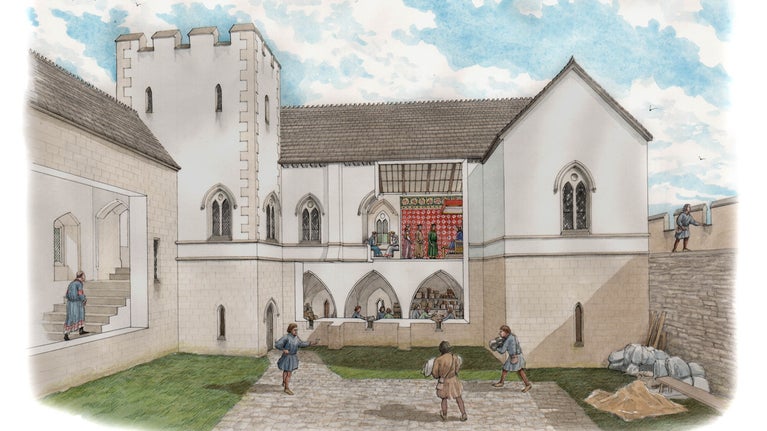
Private owners
Corfe Castle remained in Royal ownership until 1572 when it was sold by Elizabeth I (1533–1603) to her Lord Chancellor, Sir Christopher Hatton (1540—91). Among his titles was Admiral of the Purbeck Fleet, which gave him the right to fit out warships both to defend England against invaders and to capture enemy vessels as prizes. He also invested in the expeditions of the colonial explorer, privateer and trader of enslaved people, Sir Francis Drake, who named his ship the ‘Golden Hind’ after the Hatton family arms.
Christopher never married, so his estates passed to his nephew William Newport (1560–97), who changed his name to Hatton. William’s widow, courtier Lady Elizabeth Hatton (1578–1646), inherited them on his death. Little is known about Elizabeth’s ownership of the castle, but historic surveys show that she developed pleasure gardens inside and outside the walls. In 1635 Corfe Castle and its estates were purchased by Sir John Bankes, Attorney General to Charles I. The following year he also purchased the Kingston Lacy estates.
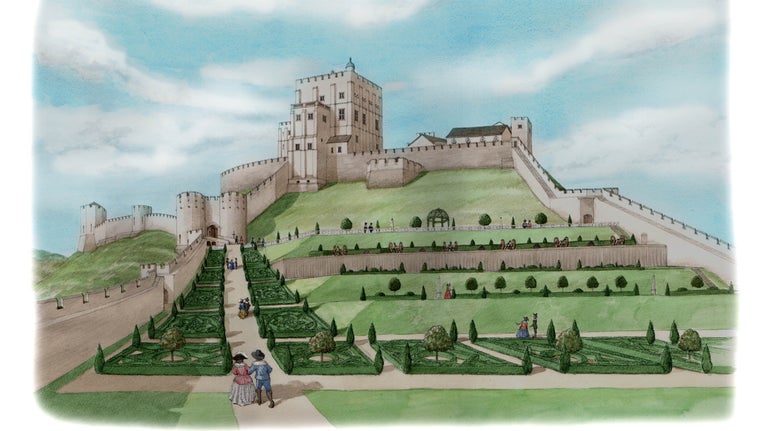
Civil war and destruction
The Bankes family sided with the King during the British Civil Wars (1642–52). John’s wife, Mary, Lady Bankes (1598–1661), successfully defended the castle during the first siege of 1643, earning her the moniker ‘Brave Dame Mary’. Oliver Cromwell’s Parliamentary forces captured Corfe in February 1646 during a second siege. The castle fell following the betrayal of Lieutenant-Colonel Pitman who allowed Parliamentary troops dressed as reinforcements to enter. In March Parliament passed an order for the castle’s demolition. A team of skilled sappers used explosives to blow its walls apart.
Return and restoration
John died during the wars in December 1644. In 1647 Mary petitioned Parliament to restore her estates, which were returned following payment of fines. Instead of rebuilding the castle, John and Mary’s son, Sir Ralph Bankes (1631–1677), chose to build the new family home at Kingston Lacy near Wimborne. The estates of Corfe Castle and Kingston Lacy remained in the family for over 300 years.
Throughout the late 17th and 18th centuries, Corfe Castle was looted for building materials, and the ruins started to deteriorate. In its ruined state, Corfe Castle became a tourist attraction and inspired Romantic era artists such as J.M.W. Turner. In the 19th century, work was carried out to stabilise the structures, with further consolidation undertaken by the Ministry of Works in the mid 20th century.

National Trust ownership
In 1982, the estates of Corfe Castle and Kingston Lacy were bequeathed to the National Trust in the will of Henry John Ralph Bankes (1902–1981), the seven times great grandson of Sir John Bankes. The Bankes estate is one of the most generous gifts in the National Trust's history. In 1986, the Trust embarked on an exciting period of archaeological research, revealing stories that had lain hidden for centuries. Among the discoveries was a rare Dutch-made stink/smoke bomb, an early form of grenade, found in the Outer Gatehouse.
Excavations in the Fourth Tower revealed the original flooring, which had been buried beneath several feet of soil and rubble. Throughout the site, extensive medieval pottery items were uncovered, forming one of the most significant collections in Dorset.
The National Trust is committed to conserving the ruins, enhancing visitor access and facilities, and mitigating the wear and tear caused by visitor footfall. Major structural conservation projects have been carried out, particularly on the Keep and Gloriette, and in 2010 the Trust received a Royal Institute of Chartered Surveyors South West Award for Building Conservation. 2023 marked the start of the largest conservation project in the castle's history, which will ensure that Corfe Castle can be enjoyed by generations of visitors to come.
Further reading
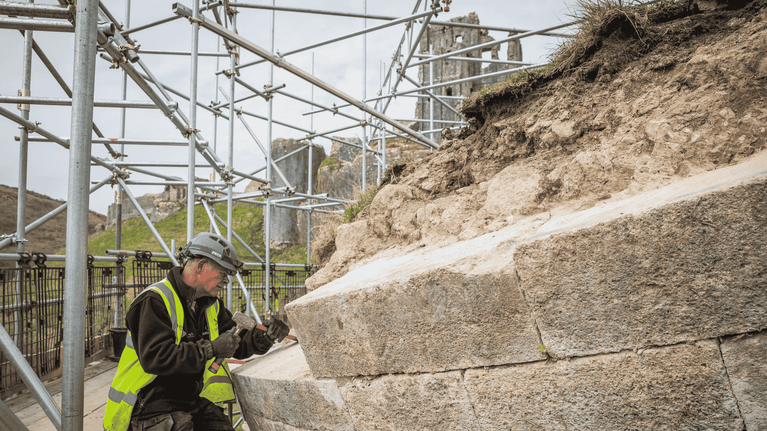

You might also be interested in
Caring for Corfe Castle
Looking after Corfe Castle is a vast and complex task with access being one of the most significant challenges. We are in the final phase of a 3-year, £2m conservation project with a dedicated team working throughout the seasons to ensure the castle endures for future generations.
Watch Corfe Castle on Hidden Treasures of the National Trust
We’re one of the places featured in series three of BBC Two’s Hidden Treasures of the National Trust. The show goes behind the scenes to hear from the experts who look after treasured objects, including a long-hidden archway at Corfe Castle, in episode 4.
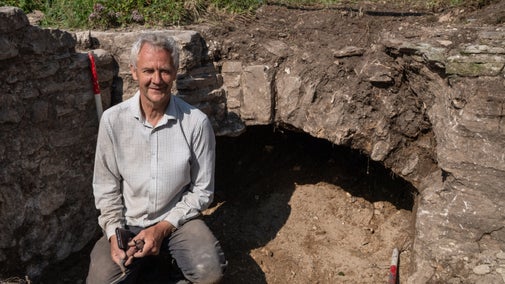
Walk in my Footsteps Audio tour
Walk in the footsteps of eight historical characters, to understand their unique perspective of Corfe Castle
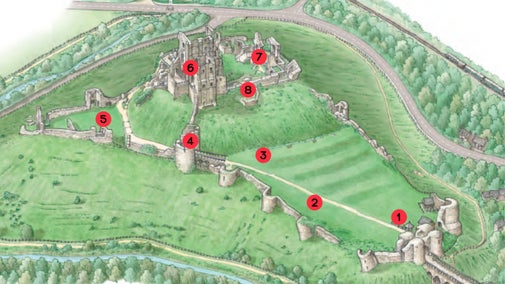
Things to see and do at Corfe Castle
Corfe Castle offers plenty to see and do, including walks around the ruins, a audio trail and wildlife spotting in the surrounding hills. Find out more.

History
Learn about people from the past, discover remarkable works of art and brush up on your knowledge of architecture and gardens.
